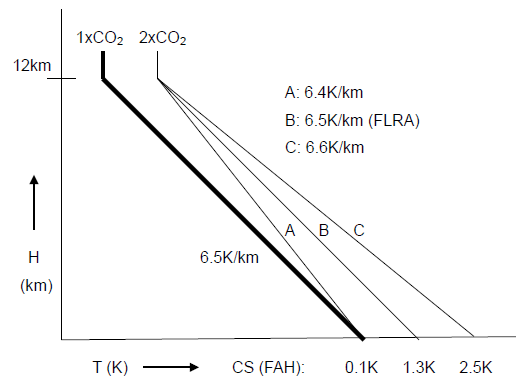This is an interesting study. I’ve not got time to look at it in detail, but I can’t obviously spot anything wrong with it.
Why the basic global warming hypothesis is wrong; CO2 climate sensitivity exaggerated 21X
What it suggests is that the Lapse rate is not a constant irrespective of CO2 as those producing the 3C warming estimates assume, but that the lapse rate changes with CO2 levels. And because the important heat exchange is at the top of the atmosphere (see advanced greenhouse model), the effect is to counter the change in CO2 with a change in lapse rate

Parameter sensitivity analysis of the lapse rate for 2xCO2. CS (FAH): Climate sensitivity with the fixed absolute humidity.
The summary
Four eminent modellers formed the central dogma of the IPCC AGW theory. Their theory claims the zero feedback climate sensitivity (Planck response) is 1.2 ~ 1.3 K for 2xCO2. When multiplied by the feedback factor of 2.5, this gives the canonical climate sensitivity of 3 K claimed by the IPCC .
However, this IPCC dogma fails due to the lack of parameter sensitivity analysis of the lapse rate for 2xCO2 in the one dimensional model (1DRCM). The dogma also contains a mathematical error in its derivation of the Planck response by Cess (1976). Therefore, the IPCC AGW theory and its canonical climate sensitivity of 3 K for 2xCO2 are invalid.
This study derives a climate sensitivity of 0.14 K from the energy budget of the earth.
Implications
I’ve been suggesting that CO2 sensitivity is around 0.2 to 0.5 assuming moderate to strong negative feedbacks. If this figure is right, then the effect could be 0.03 to 0.15C warming over a century. That is so small, there is no chance at all of anyone detecting that level of warming – more so because natural variation could be up to an order of magnitude larger.
If this is right, it now means history books will not be writing our society up as “hysterics” but instead “completely ignorant morons”.


You might find this interesting: http://meta-analysis.cz/climate/climate_sensitivity.pdf
An interesting study, but I’m not sure the test is unique to publication bias”. Also, the biggest bias is because they all fundamentally use a period of natural climate warming which just happened to coincide with CO2 rise. Based on the behaviour of the temperature, over long periods, I’m confident that the rise will be less than 1C (i.e. negative feedbacks). So, none of them are anywhere near the right value – which makes a comment by me different.
New study suggests 0.14C warming for doubling of CO2
A new study?
So, how about this study – from 1971?
ATMOSPHERIC CARBON DIOXIDE AND AEROSOLS:
Effects of Large Increases on Global Climate.
Abstract.
Effects on the global temperature of large increases in carbon dioxide and aerosol densities in the atmosphere of Earth have been computed. It is found that, although the addition of carbon dioxide in the atmosphere does increase the surface temperature, the rate of temperature increase diminishes with increasing carbon dioxide in the atmosphere. For aerosols, however, the net effect of increase in density is to reduce the surface temperature of Earth. Because of the exponential dependence of the backscattering, the rate of temperature decrease is augmented with increasing aerosol content. An increase by only a factor of 4 in global aerosol background concentration may be sufficient to reduce the surface temperature by as much as 3.5 deg.K. If sustained over a period of several years, such a temperature decrease over the whole globe is believed to be sufficient to trigger an ice age.
The rate at which human activities may be inadvertently modifying the climate of Earth has become a problem of serious concern . In the last few decades the concentration of CO2 in the atmosphere appears to have increased by 7 percent . During the same period, the aerosol content of the lower atmosphere may have been augmented by as much as 100 percent .
How have these changes in the composition of the atmosphere affected the climate of the globe? More importantly, is it possible that a continued increase in the CO2 and dust content of the atmosphere at the present rate will produce such large-scale effects on the global temperature that the process may run away, with the planet Earth eventually becoming as hot as Venus (700 deg. K.) or as cold as Mars (230 deg. K.)?
We report here on the first results of a calculation in which separate estimates were made of the effects on global temperature of large increases in the amount of CO2 and dust in the atmosphere. It is found that even an increase by a factor of 8 in the amount of CO2, which is highly unlikely in the next several thousand years, will produce an increase in the surface temperature of less than 2 deg. K.
However, the effect on surface temperature of an increase in the aerosol content of the atmosphere is found to be quite significant. An increase by a factor of 4 in the equilibrium dust concentration in the global atmosphere, which cannot be ruled out as a possibility within the next century, could decrease the mean surface temperature by as much as 3.5 deg. K. If sustained over a period of several years, such a temperature decrease could be sufficient to trigger an ice age!
Schneider S. & Rasool S., “Atmospheric Carbon Dioxide and Aerosols – Effects of Large Increases on Global Climate”, Science, vol.173, 9 July 1971, p.138-141
Those results were bases on a climate model developed by none other than James Hansen, incidentally.
TOO LATE – I thought it was serious until I saw the date.